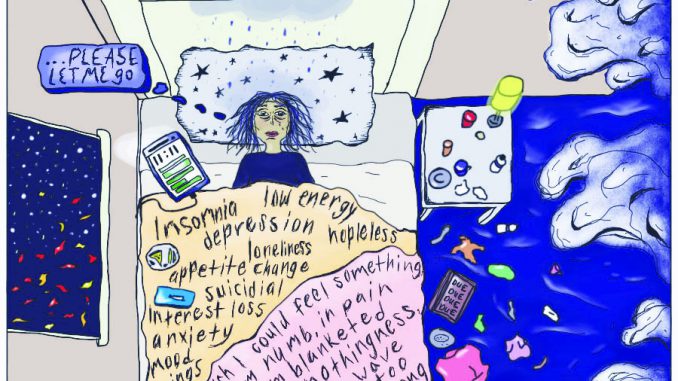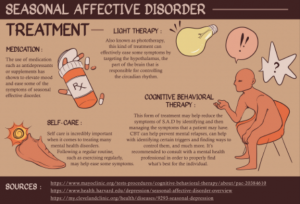
Illustration By Katlyn Marotz, Senior Managing News & Sports Editor
Infographic By Samantha Mandujano, Chief Illustrator
Article By Dahila Alanis, Staff Writer

Not many people are aware of the effects daylight savings can have on people, yet millions of people are negatively affected when the seasons change and the days grow darker and longer, according to mental health experts.
The sun going down early can affect daily tasks. Seasonal affective disorder — more commonly known as SAD — is a type of depression that’s related to change in seasons. SAD is not considered a separate disorder but is a type of depression characterized by its recurrent seasonal pattern, with symptoms lasting about four to five months per year.
During the winter period, the symptoms may include oversleeping, overeating — craving sugars, starches, and fiber — weight gain, and social withdrawal, according to the National Institute of Mental Health (NIMH).
Scientists do not understand what causes SAD, but research indicates that people with SAD may have reduced activity of the brain chemical lacking neurotransmitter (serotonin), which regulates moods.
Sunlight can also be a major factor in moods, it controls the level of molecules that maintains serotonin levels. People who are affected by SAD may find that their serotonin levels are not properly regulated. This causes a decrease in serotonin during the winter period. Further discoveries show that there is an abundance of melatonin (which maintains a normal sleep cycle) in the body with people who have SAD which causes them to feel more sleepy.
A lack of sunlight exposure affects the body as well. When the sun hits the body, the body produces vitamin D and scientists suspect that helps boost serotonin levels. Vitamin D can also be added to a diet.
Studies have shown that SAD occurs more in women than men because it’s connected to estrogen levels. Depending on where a person lives, this can also affect a person diagnosed with SAD.
Some ways people conquer their seasonal depression is light therapy which could involve using a special lamp that is made to simulate the sun or allow sunlight into the room. Another way is going to see a psychologist or take medications prescribed by a doctor.
Many people suffering from seasonal affective disorder take steps to keep their mood and motivation steady throughout the year.
For more information on SAD, visit the National Institute of Mental Health website.

